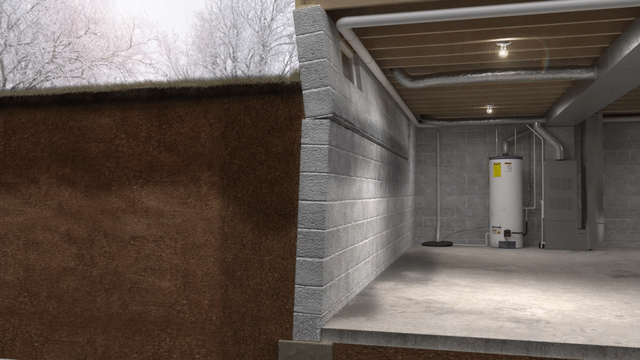Why Foundation Walls Bow More in Winter: The Freeze-Thaw Pressure Explained
The Freeze–Thaw Cycle and Your Foundation
The soil surrounding your home contains water. When temperatures drop below freezing, that water expands. When temperatures rise, it contracts back down. This ongoing cycle of expansion and contraction places repeated sideways pressure on your basement walls.
This force is strongest at the frost line — the depth to which the ground freezes — which can extend several feet deep in our region. The deeper the freeze, the more pressure your walls endure.
Over several winters, this pressure can:
-
Bow a foundation wall inward
-
Cause horizontal cracks (a key warning sign of structural stress)

-
Create stair-step cracks in block walls
-
Allow water seepage during thaw cycles
This is not a single event — it’s a seasonal stress that builds over time.
Why It Happens More in Minnesota & Wisconsin
In our climate, frost penetration is deep.
The colder the winter and the wetter the soil, the greater the expansion pressure.
This risk increases when:
-
The soil around the home contains clay (clay holds more moisture)
-
Gutters drain too close to the foundation
-
Grading slopes toward the home
-
The basement was backfilled improperly during construction
In these situations, the soil holds more moisture → freezes → expands → and pushes against the wall even harder.
What to Look For
You may see:
| Sign | What It Means |
|---|---|
| Horizontal crack across the wall | Early stage bowing from lateral soil pressure |
| Stair-step cracks in block walls | Foundation shifting under stress |
| Wall curves inward or leans | Progressive wall movement |
| Water along the base of the wall | Pressure forcing water through weak points |
If these signs appear, the wall is under winter stress — and will typically worsen until stabilized.

Does It Fix Itself in Spring?
No.
When the soil thaws, the pressure reduces, but the wall does not push itself back outward.
Once a wall bows, it requires structural stabilization to prevent further damage.
How DBS Repair Permanently Stabilizes Bowing Walls
We install systems designed specifically for cold-climate foundation movement and long-term structural stability:
Geo-Lock™ Channel Anchors
Anchors the wall to stable, undisturbed soil further from the home. This stops inward movement and helps straighten the wall over time.
PowerBrace™ I-Beam System
Galvanized steel beams brace the wall from the inside. They can be tightened gradually to restore the wall to a more vertical position.
EverBrace™ Wall Restoration System
Used when a foundation wall is severely compromised or failing. EverBrace™ transfers the weight of the home onto a new reinforced steel and foam panel system, essentially creating a new, engineered wall inside the existing one—without the cost and disruption of total wall replacement.
Helical & Push Piers
Installed when the foundation is also settling or sinking, these piers transfer the weight of the home to stable load-bearing soil or bedrock.
No two homes have the same wall condition, soil type, frost impact, or structural load.
Our team evaluates the whole home, then recommends the right long-term solution to restore safety, stability, and peace of mind.
Schedule a Free, No-Obligation Foundation Inspection
Addressing wall movement early prevents costly structural repairs later. Winter is often when changes are most noticeable — and the best time to get ahead of it.
DBS Repair specializes in basement waterproofing, foundation repair, insulation, and concrete lifting and leveling for healthy, safe, comfortable homes.
Duluth Office: 1-218-525-0720
Metro Office: 1-218-525-0720
dbsrepair.com


